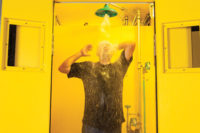QUESTION:
How do I determine the number of emergency showers and eyewashes I need for my facility? And how do I know if I need showers or eyewashes?ANSWERS:
The ANSI standard requires that emergency equipment be readily accessible. Equipment should be located on the same level as the hazard (maximum of ten seconds away) and the path of travel must be free of obstructions. So the facility should be surveyed to ascertain:1) the number of hazardous locations you have; and,
2) how many workers could be exposed at each location.
Once that data has been assembled facility-wide, an emergency equipment plan can be developed.
To determine if a shower or eyewash is needed one must consider the hazard. If the hazard is a splash in a lab sink, then an eyewash is most likely appropriate. If the hazard is a possible burst pipe, then a combination shower/eyewash is indicated.
Casey Hayes, Engineering Manager, Haws Corp.
Each facility should have a risk assessment completed to provide a review of their hazards, and calculate emergency appliances per these risks. Emergency eyewashes, showers and any optional drench hose should be located within ten seconds travel of each workstation where workers may be exposed to materials hazardous to the eyes and skin.
Locate the emergency appliance immediately adjacent to strong acids or caustic. Single stations may provide coverage for more than one hazard if the risk assessment indicates that no more than one incident can occur at a time, and if the appliance is unobstructed and on the same floor level.
Jim Johnson, Vice President - Emergency Shower and Eyewash, Encon Safety Products
First, a safety professional should assess the potential hazards in the work environment. It’s critical to determine the location and type of hazards, such as chemical exposure or flying dust and debris that may pose a danger. An emergency drench shower or eyewash should be within ten seconds reach of the hazard, without obstructions in the way. This requirement can impact the number of emergency fixtures needed.
When determining the type of fixture, generally an eyewash is used if the primary risk is to the eyes. For risks to larger surfaces of the body, a drench shower should be installed.
Rebecca Geissler, Product Manager, Emergency Fixtures, Bradley Corp.
The size of the facility, the number of personnel, and the number of areas where hazmat type chemicals are stored and in use all need to be factored into this equation. In the analysis remember that even seemingly innocuous places like restroom closets store chemicals that could prove dangerous if spilled/splashed into the eyes.
And how do you know if you need showers or eyewashes? If you store, use, or manufacture any chemicals that rate above an irritant to human membranes then you need emergency showers and eyewashes to protect your personnel.
Mark Conron, President, FSI North America, a division of Fire Safety International
The simple answer — eyewash stations must be no more than ten seconds away from a hazard site. OSHA’s Part 1910.151(c) states, “Where the eyes or body of any person may be exposed to injurious corrosive materials, suitable facilities for quick drenching or flushing of the eyes and body shall be provided within the work area for immediate emergency use.â€
Work areas involving painting, solvents, battery charging, laboratory work, chemical storage, and chemical pumping/mixing are required by ANSI Z358.1-2004 to install eyewashes. Construction sites, loading docks, agricultural locations, and other emergency response areas require a decontamination shower in accordance with OSHA 1910.120.
Stacey Theroux, Product Communications Specialist, Fendall Product Group, Bacou-Dalloz

